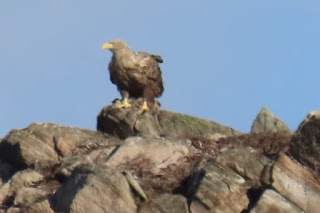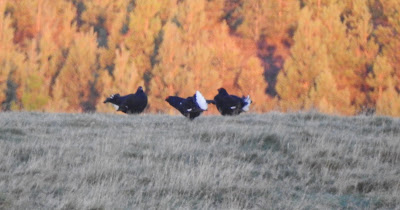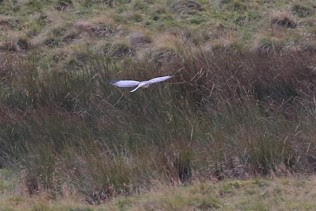October 2023
October 2023 was yet another very changeable month weather-wise in this area, which saw us enjoy some pretty decent, mild and sunny weather at times, but this was offset by some wild, wet and windy weather courtesy of three named storms, 2 mid-month, one late month, and some frosty days and the first snow on the mountains later in the month.
Temperatures ranged widely from a balmy +12c to a chilly -4c, and the few bright and sunny days saw us get our first proper frosts of this autumn, while the 21st saw our first snowfall linger on the mountain tops, so any prospective visitors would be wise to pack a good variety of clothing..
Though the days are certainly shortening now, we still have around 10 hours (7am-5pm approx) of usable daylight, and the Highland scenery is still ablaze with glorious autumn colours, with most of the leaves still clinging on, the ferns a picture in copper, and many of our berry trees still fully laden.
The autumn rains have restored the local rivers to their normal levels, allowing the Atlantic salmon to finally reach their spawning grounds in the upper reaches.
October is a really great month to witness visible bird migration in action, with large flocks of Geese, Swans, and Thrush species often witnessed flying noisily overhead, and this influx of winter visitors from colder areas further north, helped full-day safari bird lists increase up into the 40's, (or more if you include a trip to the Moray Coast), whilst mammal day-lists varied between 3 and 7 depending on the start time and number of venues visited, with early starts, as usual, proving to be best.
 |
| Enjoying the autumn colours at a picturesque local glen |
To give you an idea of what you may realistically hope to see if you are considering a future October visit, I hope the following more detailed information, illustrated with photos taken at sites in and around the Cairngorms National Park by myself, my friends or my safari clients this month and in previous October's will help....clicking on the picture enlarges it to full-screen.
Local speciality/upland bird species seen regularly during the month included:
Red Grouse, Crested Tit, Goldeneye and Dipper, we also had several good dawn sightings of Black Grouse, some decent views of Golden Eagle , a couple of White-Tailed Eagle, and a few fleeting glimpses of Crossbills....
Newly-arrived winter visiting birds were represented by Whooper Swans, several species of 'grey' Geese, and from the first week onwards, good numbers of Redwings, and from mid-month, Fieldfares, and a few Bramblings.
A good variety of sea ducks, geese, waders and wildfowl were seen at the Moray Coast.
Mammal species seen regularly included:
Red Squirrel, Red Deer (rutting), Roe Deer, Mountain Goat , Brown Hare and Rabbit......with a few sightings of Bank Vole at forest feeding stations.
The second half of the month also saw us enjoy views of Atlantic Salmon starting to spawn in the upper reaches of our local rivers....
All photographs of wildlife, especially Schedule 1 and other protected bird species were taken legally at long range with powerful zoom lenses, or from my vehicle on public roads, well away from nest sites, and no disturbance was caused to any wildlife....
October 2023 bird sightings in more detail:
Up in the glens...
 |
| Autumn in a beautiful local upland glen |
Golden Eagle is truly an iconic bird of the Scottish Highlands, and one that always seems to be on the 'wish-list' of my safari clients, and our regular visits to my favourite upland glens paid off on a good number of occasions this month, with some pleasingly frequent and often decent sightings of these hugely impressive creatures, sometimes hunting , occasionally in aerial combat with other raptors or Ravens, or sometimes just soaring around....and, presumably lured in by the spawning Salmon, we also saw the even larger White-Tailed Eagle more frequently than normal...
 |
| Golden Eagle |
 |
| Golden Eagle |
 |
| Golden Eagle |
 |
| White-Tailed Eagles by Kathleen Robertson |
 |
| White-Tailed Eagle by Kathleen Robertson |
 |
| White-Tailed Eagle by Kathleen Robertson |
 |
| Kestrel |
 |
| Common Buzzard |
 |
| Red Kite |
Up on the moors....
 |
| Early morning on a local heather moorland |
Red Grouse, though mot a 'banker' sighting, and still largely in family groups were generally very obliging, and by using my vehicle as a 'mobile hide', we often achieved excellent close-up views and photo opportunities.. and later in the month, a few of the more 'frisky' cock birds appeared to be getting a little aggressive and territorial in their behaviour....
 |
| Female Red Grouse |
 |
| Male Red Grouse |
Visits to Black Grouse leks were a little less predictable however, with results varying from none showing at all on some occasions, to 5 displaying males on one memorable frosty morning...with seemingly no reliable pattern emerging yet. .and on the 12th, we were most surprised to happen across 1 male and 2 females on a moorland well away from any lek site....not a common occurrence...
 |
| Displaying Black Grouse |
%2018.JPG) |
| Female Black Grouse by Steve Nicklin |
 |
| Male Black Grouse, pretending to be a Red Grouse! |
%2046.JPG) |
| Black Grouse by Steve Nicklin |
In the Caledonian forests...
 |
| Autumn in a local Caledonian Forest |
Crested Tits, having been typically 'uncooperative' and elusive through the summer months, started to become more regular visitors to forest feeding stations, especially soon after dawn on the colder days, and we were fortunate enough to enjoy many excellent and often extremely close views of this true 'local speciality' as well as a couple of more random sightings of them in mixed winter flocks on our forest walks...
 |
| Crested Tit |
 |
| Crested Tit |
 |
| Crested Tit by Steve Nicklin |
A bonus by-product of regular winter feeding is sometimes (especially on colder days) being able to feed the incredibly confiding Coal Tits and (sometimes) Great Tits and Robins by hand, an experience much enjoyed by my safari clients of all ages...
 |
| Coal Tit |
On the lochs...
 |
| Early morning at a local loch |
With the summer-visiting water birds all gone now, our resident Goldeneyes, are now joined by winter-visiting Whooper Swans and Geese, alongside the more common species.....
 |
| Whooper Swans |
 |
| Goldeneye |
On the marshes...
 |
| Autumn at Insh Marshes |
Alongside the ever-present Grey Herons, waders like Golden Plover, Dunlin and Ruff were reported, numbers of newly-arrived Whooper Swans and 'grey' Geese increased throughout the month, raptors such as Kestrel, Buzzard, Red Kite, Marsh Harrier, and Hen Harrier were seen regularly, with the occasional Merlin, Golden Eagle and White-Tailed Eagle also sighted.
 |
| Male Hen Harrier |
On the rivers...
 |
| The River Spey |
Dipper is a bird absent from large areas of central, southern and eastern Britain, preferring clear, fast-flowing upland rivers over murky, slow-flowing lowland waterways. Fortunately, if you position yourself on a bridge, they can be a fairly common sighting in this area, often seen swimming and diving to feed, or perching prominently on a rock, and always prove popular with my safari clients ,
 |
| Dipper |
 |
| Dipper |
With a similar UK distribution to Dipper, Goosander can be tricky to see in much of Britain, but we often see family groups of them in this area, though they can be very wary of humans.
 |
| Goosander |
Up in the mountains....
 |
| Autumn in the Cairngorm Mountains |
Although I didn't take any walks up into the hills myself this month, from previous experience, I would expect the Ptarmigan to be morphing into their winter-white plumage now, which can make them less difficult to spot amongst the rocks, at least until the snow comes, anyway.
 |
| Ptarmigan - Photo from October 2016 |
The first snow on the tops, can sometimes encourage Snow Buntings down to lower levels, and I always carry a bag of mixed seed in the colder months, as they can sometimes be quite confiding once tempted in by a free feed, though we failed to see them this month.
On farmland....
 |
| Typical local farmland |
Although all the waders have gone, 'grey' Geese and Whooper Swans can often be seen on local farmland, and big flocks of winter Thrushes were also noted, along with the more common Pheasants ......
 |
| Greylag Geese |
 |
| Whooper Swans |
 |
| Redwings |
In local gardens;
Berry bushes and garden bird feeding stations are a real magnet for hungry newly-arrived winter visiting birds from further north, and Redwings, Fieldfares and Bramblings were all seen locally, and the first Waxwings have been reported along the north and east coasts of Scotland, and they appear to be coming this way.....
 |
| Bramblings |
 |
| Redwing |
 |
| Fieldfare |
Other good/scarce birds seen/reported locally this month included:
Golden plover, Ruff and Dunlin at Insh marshes from the 8th-11th, a 'one-day wonder' Hoopoe on the 13th, and a Common Scoter on Loch-Insh on the 20th, whilst a few late hirundines were also reported throughout the month....
A few photos of more common birds seen locally this month:
 |
| Dunnock |
 |
| Female Stonechat |
 |
| Male Bullfinch |
 |
| Male Chaffinch |
 |
| Great-Spotted Woodpecker |
 |
| Robin |
Adventures 'out of area':
 |
| Early morning at Spey Bay on the Moray Coast |
The nearby Moray Coast is always worth a visit, especially in autumn and winter, and a visit early in the month gave a good selection of auks, waders, wildfowl, seaducks, geese ,swans and gulls ....
 |
| Eiders |
 |
| Brent Goose |
 |
| Curlew |
 |
| Knots |
 |
| Ringed Plovers |
 |
| Oystercatcher |
 |
| Purple Sandpiper by Steve Nicklin |
The freshwater lochs and nature reserves just inland from the Moray Coast can be productive too....
 |
| Cormorant |
 |
| Mute Swan |
 |
| Little Grebe |
 |
| Pochard (centre) and Tufted Ducks |
 |
| Tufted Ducks |
 |
| Tree Sparrow |
October 2023 mammal sightings in more detail:
'Mammal of the month' for October just has to be the Red Deer, with their spectacular annual 'rut' providing my safari clients with some superb entertainment - the fully antlered stags 'bolving' roars echoing through the glens, as they spend much of the month posturing , fighting off rivals and attempting to mate with as many of their 'harem' of hinds as possible - surely one of British nature's 'must-see' experiences? Please be aware though, that we can usually only view the rut from a fair distance away, so photography opportunities are usually limited....
In the Caledonian forests, our Red Squirrels never failed to charm and entertain, with their cute looks, acrobatic leaping from tree to tree , reliable use of peanut feeders, gathering of drey materials and chasing off of rivals, and of course, with them being largely absent from most of the UK now, many of my safari clients were seeing them for the first time....
 |
| Red Squirrel |
 |
| Red Squirrel |
Feral Mountain Goats are mainly restricted to a few remote upland areas of the UK, and we are fortunate to have them locally in a few quiet glens, so many of my safari clients get to see them for the first time while out with me, and they proved to be fairly reliable this month...
 |
| Feral Mountain Goats |
Roe Deer, although relatively common in most of the UK, can actually be quite tricky to see due to their naturally 'nervous' nature, and the fact that they can be very 'crepuscular' - being more active at dawn and dusk...but we managed a few daytime sightings on quiet farmland , marshland and woodland edges this month..
 |
| Roe Deer Buck |
Brown Hares, similarly to the Roe Deer, can be very nervous and 'crepuscular' in nature, and most of our best sightings happen in the first hour of daylight, and that proved to be the case again this month, though the light was often too poor for decent photos...
 |
| Brown Hare |
Hairy Highland Coo's always prove to be popular with my safari clients, especially those who do not have them close to home, so don't be afraid to ask me if you fancy going to see them, and maybe even get to feed and 'pat' them, as I have a couple of great sites....
 |
| Carrot time for Murdo |
Marine mammals:
Rare/nocturnal mammals:
I get a few enquiries about the possibility of seeing Badgers and Pine Marten from my safari clients, many of whom I suspect are unaware that they are actually a largely nocturnal creature, and although we do get the occasional (maybe one or two a year) dawn glimpse of one, you would definitely have a much higher chance of seeing them at a specific dusk Badger/Pine Marten watching hide - Please contact me for more information.
Similarly, our inland Otters too are mainly active during the hours of darkness, and again, although we do get a few early-morning sightings on local lochs and rivers each year, looking for them feeding in a suitably quiet, kelp - filled bay on the coast on a rising tide, but at any time of day, would give you a much better chance.
Whilst we are still on the 'tricky to see stuff', the Scottish Wildcat too, as well as being incredibly rare now, is also generally nocturnal, and the fact that I have had a mere handful of (dawn or dusk) sightings in 17 years of providing wildlife safaris should give you an idea of how difficult they are to see.
Other wildlife:
Mid October-early December is usually the time of year to see our Atlantic Salmon spawning. These remarkable and often very large fish spawn in the shallow waters in the upper reaches of our rivers, at the very spot where they themselves were hatched several years before, having originally spent 2-3 years in the river, then another 2-3 years feeding, growing and maturing out in the mid Atlantic, before undertaking a perilous journey many miles upriver, often involving avoiding poachers, anglers and predators and negotiating high falls and rapids on the way , an amazing migration story! However, sightings are very reliant on the rivers water levels - too little water and the Salmon cannot access the upper reaches - too much water, and they can get there... but we can't see them....fortunately, from the 26th onwards it all fell into place and we enjoyed some decent views.......
 |
| Spawning Atlantic Salmon |
News:
I am very pleased to announce that Highland Wildlife & Birdwatch Safaris has recently been awarded - for the second consecutive year - a Travelers Choice accreditation from Trip Advisor, for being ranked in the top 10% of visitor attractions worldwide based on customer reviews and feedback.
This achievement would not have been possible without the support of all my family, friends, safari clients, social media followers, regular blog readers , the Visit Scotland 'mystery shoppers', and everyone else who has helped and encouraged me along the way to ‘living my dream’ of being a wildlife safari guide, since 2004, especially over the last few very difficult COVID affected years, so a big THANK YOU to you all :)
All tourism/hospitality/activities in Scotland are open , are free of restrictions and I have now completed two years of (thankfully!) increasingly busy and extremely enjoyable safaris with clients with no major issues arising.
With all national travel restrictions lifted too, Scotland is officially 'open for business' for visitors from all over the UK, and from abroad, and already this year, I have enjoyed meeting my first ever clients from Chile, and Singapore....
For those considering a visit, these wildlife/outdoor tourism websites may prove useful:
June - September is midge season - But thankfully, this area is not usually affected too badly - This link explains why:
Bumper midge hatch alert after warm spell - BBC News
https://www.gov.scot/collections/coronavirus-covid
NatureScot (outdooraccess-scotland.scot)
Can Nature Help Health? | Nature Prescriptions - YouTube
Scotland, Yours to Enjoy. Responsibly. - YouTube
Cairngorms National Park Authority
Positive prescriptions | The RSPB
COVID-19
The Scottish Highlands, being very sparsely populated, has had very few COVID-19 cases in comparison to most of the UK, and on my safaris we tend to visit remote , wild habitats well away from the more popular tourist areas, and usually have very little interaction with other people, and this is something that I intend to continue.
 |
| Autumn at Carrbridge |
Summary:
 |
| An atmospheric autumn dawn at the River Spey |
Reviews:
https://www.tripadvisor.co.uk/Attraction_Review-g186537-d3335134-Reviews-
 |
| Nice autumn colours at a local loch |
Gift Certificates:
| Safari gift voucher |










